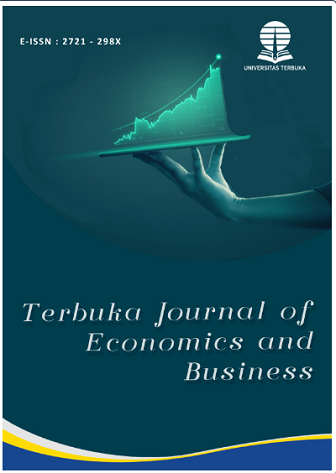Performance Measurement of Human Resources PT. Pulau Bintan Jaya Based on the Human Resource Scorecard Model
DOI:
https://doi.org/10.33830/tjeb.v2i2.2521Keywords:
Human Resource Scorecard, Performance, Strategic Human Resource ManagementAbstract
PT Pulau Bintan Jaya is one of the foreign investment companies producing crumb rubber in Riau Islands Province. The company had been in operation since 1969, producing rubber with a few measures which were Standard Indonesian Rubber (SIR) 5, SIR 10, and SIR 20 per customer request. Companies have conducted employee performance measurements but have not specifically measured employee performance by linking it to company strategic functions. Current performance assessments are not yet focused on human resource development efforts. There were still poorly educated employees who served as team leaders and as supervisors. As a result, work-related communication became difficult and led to multiple obstacles under which employment resources became inadequate, and the targets of corporate performance unattainable. There are issues relating to the quality of human resources, and companies have been declining demand and declining production rates for several months. The decline in demand from customers has become one of the issues to evaluate in the company's performance measurement, due to its inadequate strategic resource management. It requires alightnment of the work systems to capture the role of human resources, while in this regard some current case work accident are still faund annually in the production section, even though for the past three consecutive years the accident rate has declined, it needs to be figured out by performing performance measurements. A human resource scorecard measures the performance of human resources by finding solutions to the weaknesses of human managerial resources in PT. Pulau Bintan Jaya, and assist in linking mission vision and strategic objectives. In this study, the design results were obtained as follows: there are 15 strategic goals and 32 Key Performance Indicators, special elements of the human resource system can be driven by 16 performance drivers (called Lagging Indicators), and 16 performance outputs to be achieved (called Leading Indicators), while the results Measurement of employee performance in PT Pulau Bintan Jaya using the Human Resource Scorecard method obtained good results.
References
AA. Anwar Prabu Mangkunegara. (2005). Human Resources Performance Evaluations. Refika Aditama: Bandung. 9-14
Astuti, et. Al., (2015). Design Enhancement of Human Resources in The Blood Donor Unit (UDD) Indonesian Red Cross (PMI) Bandung City using The Method Human Resource Scorecard. The Department of Industrial Engineering's Final Entry Journal.Vol.2, No.1. ISSN :2355-9365.
Akbar Surya. (2018). Analysis of Factors that Affect Employee Performance. Journal of The Study of Science Administration of The State STIA Indragiri. JIAGANIS Vol. 3, No. 2 September 2018: 1-17.
Becker, Brian E. (2009). The HR Scorecard; Lingking People, Strategy, and Performance [USA: Harvard Bussiness Schooll Press, 2001]. English translation by Dian Rahadyanto Basuki, The HR Scorecard; Human Connection, Strategy and Performance. Jakarta: Erlangga. 12-74
Erlinda Muslim and Frinda Firania. (2016). Designing The Human Resource Scorecard As A Performance Measurement of Human Resource. The Technology Management JournalVol.15 No.1, 24 Mei 2016 : 1-10
Ermayanti Dwi. (2015). Human Resource Performance Measurements Scorecard Methods as Optimizing Organizational Performance. The Accounting and Business Journal. Vol. 15 No. 1, Februari 2015: 57-63.
Ismail. (2018). The Design of Human Resource Performance Assessment Systems scorecard. North Sumatra University Thesis. 37-42
Kaswan. (2019). Strategic Human Resource Management.; Concepts, History, Models, Strategies, and Contributions of Human Resources. Yogyakarta: ANDI. 71-79
Lorisa dan Doaly. (2017). The Measuring of The Performance of Human Resources with the Human Resource Scorecard in PT. Trio Jaya Steel. Industrial Engineering Journal. Vol. 7 No.3. ISSN: 1411-6340. 1-14
Merdeka.com. Purposive Sampling is a special-sampling sampling technique, compulsory to know. Downloaded on September 6, 2021, from the site wold web: https://www.merdeka.com/jatim/purposive-sampling-adalah-teknik-pengambilan-sampel-dengan-ciri-khusus-wajib-tahu-kln.html?page=2
Meisy Layasina Sembiring. (2019). Human Resource Performance Analysis with The Concept of Human Resource Scorecard in Prime Royal Hospital. Master's Graduate School of Business Management of The University of North Sumatra. Medan.37-51
Mulyana Deddy. (2013). Qualitative Research Methods of New Participle Communication and Other Social Sciences. Bandung: PT. Remaja Rosdakarya. 180-182
Musriha, Diana Rapitasari. (2019). Employee Performance Improvement and Organizational Change with SWOT Analysis Positioning for Commercial Banking Center in Mandiri Bank Surabaya Indonesia. International Journal of Recent Technology and Engineering (IJRTE). ISSN: 2277-3878, Volume-8 Issue-3S2, October 2019. (hlm. 2)
Optimizing Organizational Performance. The Accounting and Business Journal. Vol. 15 No. 1, Februari 2015: 57-63.
Rachid Belhaj and Mohamed Tkiouat. (2017). A new Framework of Strategic Human Resource Management (SHRM) Based on Quantitative and Qualitative Data, American Journal of Applied Sciences.( hlm.1)
Raditya Ardianwiliandri, Remba Yanuar Efranto and Amelia Handini. (2018). The Measuring of Human Resources' Performance with The Approach To Human Resources Scorecard. The Scientific Journal of Industrial Engineering. Vol. 6 no. 3, 185-194.
Raden A. A. R. P. Sari, Awanis L. Haziroh, Amanda D. Pramadanti, and Febrianur I. F. S.Putra, 2021, The Moderating Role Of Self Efficacy Toward Multiple Role Conflict And Job Performance, Terbuka Journal Economics Business
Ramadan.et. al., the Planning and Measuring of The Performance of Human Resources with The Method of Human Resource Scorecard (a study of the PG. Krebet Baru, Bulilawang) email: della.ginza.ramadhan@gmail.com, nazzyr_lin@ub.ac.id, remba@ub.ac.id 185 – 194
Sobirin, Achmad. (2016). The Performance Management Materials Textbook; 1 – 9/EKMA5320/ 3 sks/, – Cet.3; Ed.1 --. Tangerang Selatan: Universitas Terbuka.1.19-1.21
Sopiah dan Etta Mamang Sangadji. (2018). Human Resource Management Strategy; –Ed.1 - Yogyakarta: ANDI. 65-50
Sugiyono. (2013). Quantitative Research Methods, Qualitative and R&D. Bandung: Alfabeta. 80-138
Sumarsan. (2018). Management Control Systems: Concepts, Applications, and Performance Measurements. Jakarta : PT. Indeks 269-276
University of Psychology (2019) Dimensions of Performance and Factor (assessment) of Employee Performance by Experts. Downloaded on February 19, 2021, from the world web site: https://www.universitaspsikologi.com/2019/12/dimensi-kinerja-dan-faktor-penilaian-karyawan.html
Prox Consulting. Purpose and value evaluation/performance assessment. Downloaded on February 19, 2021, from the world web site: https://proxsisgroup.com/tujuan-dan-pengertian-evaluasipenilaian-kinerja/
Downloads
Published
How to Cite
Issue
Section
License
Copyright (c) 2021 Terbuka Journal of Economics and Business

This work is licensed under a Creative Commons Attribution-ShareAlike 4.0 International License.




